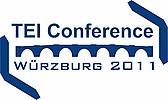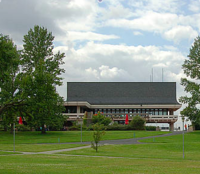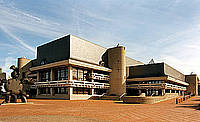Pre-Conference Tutorials
As in previous years, the meeting will be accomponied by pre-conference tutorials on various TEI related topics. This will give delegates the opportunity to learn from experienced practitioners in the field. Please make sure to register for participation in tutorials as early as possible as places are limited. Tutorials can also be booked independently from conference attendance.
The following tutorials are open for registration:
- Using the Scalable Architecture for Digital Editions (SADE) for the digital presentation of TEI encoded texts
- Tuning oXygen XML Editor for TEI
- Using TILE to build links between text and images in TEI projects
- TextGrid
- Preparing a Critical Edition of an Incunabla with TEI
See below for details. In addition, several workshops will be offered.
Using the Scalable Architecture for Digital Editions (SADE) for the digital presentation of TEI encoded texts
This tutorial had to be cancelled.
Tuesday, 11 October 2001, 10-17h, Hubland-Campus, ZHSG 1.003
Instructor: Alexander Czmiel, Berlin Academy of Sciences
Registration fee: US$ 100
The Telota working group of the Berlin-Brandenburg Academy of Sciences and Humanities wants to offer a tutorial on the Scalable Architecture for Digital Editions (SADE). The tutorial aims to introduce SADE as publication framework for any kind of text based digital resources. It will show the participants the various deployment methods and explain how the different components (XML database, image viewer, front-end etc.) of SADE work together. In the hands-on-section of the tutorial the participants will learn how to deploy SADE themselves and how to adjust the provided XQuery, XSLT and CSS-scripts for their own needs. As SADE comes with native support for TEI encoded texts it serves as an appropriate tool to query, transform and publish these texts. The included image viewer digilib in turn is a proper tool for text-image-linked presentations.
The target audience are (digital) humanists with good knowledge of XML/TEI and HTML and at least basic knowledge of XSLT, XQuery and XPath, who plan to produce an own digital edition based on the TEI guidelines.
References:
Tuning oXygen XML Editor for TEI
Tuesday, 11 October 2011, 10-14h, Hubland-Campus, ZHSG 1.006
Instructor: George Bina, Syncro Soft / oXygen XML Editor
Registration fee: US$ 50
This tutorial will provide an overview presentation of the oXygen features going into details on the TEI specific support and on the parts that are generally used in relation with TEI work. oXygen comes with built-in support for TEI but this support is not hard coded, it is just a default configuration that can be extended/modified/customized according to your needs. I will explain what the default TEI support consists of and how this can be customized and shared within a group of users. We will discuss also validation technologies like Schematron or NVDL, working with XML databases, processing/querying documents, etc. I am open also to any topic from the audience and part of the tutorial will be an open discussion on any TEI - XML - oXygen related topic.
Using TILE to build links between text and images in TEI projects
This tutorial had to be cancelled.
Wednesday, 12 October 2011, 10-17h, Hubland-Campus, ZHSG 1.006
Instructor: Dot Porter
Registration fee: US$ 100
Aimed at student and faculty scholars with intermediate to advanced experience using TEI or XML, this course will provide an introduction to using TILE, the Text-Image Linking Environment, to build various types of links for TEI projects (http://tileproject.org/). Working with the Image markup plug-in and the Semi-automated line recognizer in the online installation of TILE, during the morning we will look at a variety of different TEI files that represent links between text and image, for example manuscripts and transcriptions of the texts contained in them, paintings and poems written to describe them, and illustrations and annotations describing them. During the afternoon students will work with their own TEI files in TILE. The instructor will provide materials for students who do not bring their own.
An introduction to working with the TextGridLab
Wednesday, 12 October 2011, 10-17h, Hubland-Campus, ZHSG 1.003
Instructors: Oliver Schmid, Celia Krause and Philipp Vanscheidt (Darmstadt University of Technology)
Maximum number of participants: 20
Registration fee: US$ 100
The joint project TextGrid aims to support access to and exchange of data in the arts and humanities by means of modern information technology. TextGrid serves as a virtual research environment for philologists, linguists, musicologists and art historians. As a single point of entry to the virtual research environment, TextGridLab(oratory) provides integrated access to specialized tools, services and content. TextGridRep(ository) is a long-term archive for research data in the humanities embedded in a grid infrastructure, which will ensure availability and access to its research data as well as interoperability.
The workshop will introduce the basics of working with the TextGridLab. A brief theoretic introduction will lay the groundwork for the interactive main section of the course. First of all, the basic knowledge of the project and the infrastructure of TextGrid will be imparted, then the general tools are presented and tested by the participants during the interactive section. Subsequently, the expert tools are brought into focus, prioritizing the work with TEI encoded texts and image files using the Text Image Link Editor. Furthermore, the functional range of the XML Editor and the Metadata Editor is presented as well as further expert tools.
References:
- www.textgrid.de/en/startseite.html (project page)
- www.textgrid.de/en/1-0.html (overview of TextGridLab tools)
- www.textgrid.de/en/1-0/download.html (software download)
Preparing a Critical Edition of an Incunabula with TEI
Tuesday, 11 October 2011, 13-17h, Hubland-Campus ZHSG 1.004
Instructor: Guenther Goerz, Univ. of Erlangen-Nuremburg, Josef Schneeberger, Hochschule Deggendorf, Klaus Thoden, MPI für Wissenschaftsgeschichte, Berlin
Registration fee: $50
Digital editions of incunabula --- books printed before 1500 --- provide a number of challenges. Many practices from the manuscript culture survived in typesetting for some time, e.g. the use of a large number of special glyphs for ligatures and abbreviations. Word breaks at the end of lines are often unsystematic and in many cases there is no hyphenation sign at all. In many cases, spacing between words is rather narrow and sometimes also missing. Furthermore, punctuation marks are missing or put in places where one would not expect them, such that sentence borders cannot always be recognized clearly. Of course, there is no normalized spelling such that many variants of words occur, sometimes even with erroneous spelling.
In this workshop, we will take up a practical example to discuss the decisions to be made to solve the aforementioned problems in the framework of TEI. Our example is the “Deutsche Ptolemaeus”, a geographical work written in early modern German and printed around 1490, of which only two copies are extant. TEI offers facilities for semantic annotations, e.g. for person and place names (named entities), and technical terms. Furthermore, it provides means for linking with lexical resources, glossaries, and comments. Most tools of computational linguistics are only to a certain extent suitable to deal with the particular linguistic variety which is a dialect variant of early modern southern German. Hence, some specific heuristics have to be developed to at least partially automate the tagging process. Furthermore, we will present specific scripts in XSLT to produce different versions of the transcription, XHTML, raw text, and printed editions.
This tutorial is taught in German language.






